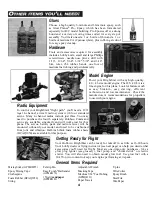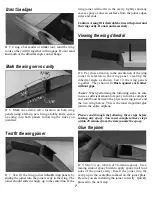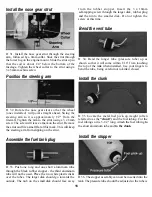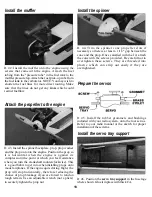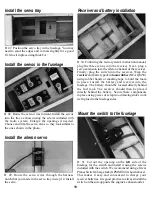
Glues
Choose a high quality 6-minute and 30-minute epoxy, such
as Great Planes* Pro- Epoxy, which has been formulated
especially for R/C model building. Pro Epoxies offer a strong
bond and a variety of curing times suited for every step of
assembly. You'll also need a 1 oz. bottle of thin and a 1 oz.
bottle of medium CA (Cyanoacrylate), plus rubbing alcohol
for easy epoxy cleanup.
Hardware
Tools and accessories required for assembly
include a hobby knife, small and large Phillips
screwdrivers, needle nose pliers, drill with
1/16", 11/64", 5/64", 3/32", 5/32" and 3/16"
bits, ruler, #64 rubber bands, one foot of
medium fuel tubing and petroleum jelly
Model Engine
Power your BrightStar with any high-quality,
.40 - .46 size model engine. The O.S. .40 LA is a
fine engine for this plane. Look for features such
as easy break-in, easy starting, efficient
carburetion and low maintenance. Check the
manufacturer's recommendations for propellers
to use with your engine.
Radio Equipment
To control your BrightStar's "flight path," you'll need a 1991
legal 4-channel aircraft radio system with four standard
servos. Many 4-channel radios include just three. You may
need to purchase the fourth separately. Hobbico Command
servos are available singularly and will work great for this
plane. The servos, battery pack and radio receiver will be
mounted onboard your model and need to be cushioned
from jolts and vibration. Half-inch thick foam rubber sheets
(HCAQ1050) are available for this purpose.
Getting Ready for Flight
Your Hobbico BrightStar can be ready for takeoff in as little as 16-20 hours.
Your hobby dealer or flying instructor (see next page) can help you decide what
accessories you'll need for flight. Most are one-time-only purchases - like a
glow plug igniter (see glossary), fuel pump, and "chicken stick" or electric
starter. You will also need to obtain model glow fuel. Use glow fuel with a
10-15% nitro content to keep your engine performing at its peak.
General Items Required
Mixing Sticks (GPMR8055)
Epoxy Mixing Cups
Clothespins
Foam Rubber (HCAQ1050)
String
Felt-tip Pen
Easy-Touch" Bar Sander
(GPMR6170)
150-grit sandpaper
(GPMR6183)
Adjustable Wrench
Masking Tape
Medium 3/32" Fuel Tubing
(GPMQ4131)
Paper Towels
T-pins
Wire Cutter
Epoxy Brush
Steel File
Wax Paper
4




